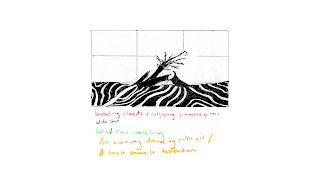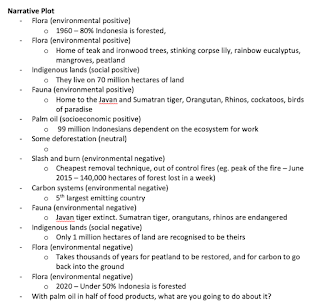This week, we finished animating all the stop-motion elements of the documentary. We only had to take a photo of a burnt tree, (which would form part of a mainly collage background) so this was easy enough to do.
Now there were only the collage parts left to do. I joined in with the others to help speed up the process. I put together some of the frames that had the tree and mountain backgrounds. The mountains were easy enough to do, due to their basic shape and I could use much bigger pieces of paper to collage them. The trees on the other hand were very fiddly and needed much smaller bits of paper to cover the detailed areas. Overall, this made collaging a very slow way of animating, and although I like the outcome, I prefer the more regular process of animating in stop-motion.
- Basoap (2014) Growing Bulbous nose. Available at: https://freesound.org/people/basoap/sounds/233201/ (Downloaded 25th April 2021)
- Bratendu (2020) Cuckoo. Available at: https://freesound.org/people/bratendu/sounds/506675/ (Downloaded 25th April 2021)
- Dynamicell (2006) Fire_Embers_Large_Campfire. Available at: https://freesound.org/people/Dynamicell/sounds/17554/ (Downloaded 25th April 2021)
- FractalStudios (2016) Fire Crackle and Flames 002. Available at: https://freesound.org/people/FractalStudios/sounds/363092/ (Downloaded 25th April 2021)
- Garuda1982 (2021) Wind Storm Gusts of Wind up to 7 Beaufort City atmo. Available at: https://freesound.org/people/Garuda1982/sounds/563047/ (Downloaded 25th April 2021)
- Guyburns (2016) Yellow Throated Honeyeater. Available at: https://freesound.org/people/guyburns/sounds/333879/ (Downloaded 25th April 2021)
- Idomusics (2020) Rain. Available at: https://freesound.org/people/idomusics/sounds/518863/ (Downloaded 25th April 2021)
- Mafon2 (2016) Water Click. Available at: https://freesound.org/people/Mafon2/sounds/371274/ (Downloaded 25th April 2021)
- Reinsamba (2006) Bird in Rainforest. Available at: https://freesound.org/people/reinsamba/sounds/19257/ (Downloaded 25th April 2021)
- Skipjack2001 (2009) Rainforest. Available at: https://freesound.org/people/skipjack2001/sounds/68065/ (Downloaded 25th April 2021)
- Sqeeeek (2017) Wind_Gust_Short_Sqeeeek. Available at: https://freesound.org/people/sqeeeek/sounds/381853/ (Downloaded 25th April 2021)
- Tranquility.jadgroup (2016) Greater Bird-of-Paradise. Available at: https://freesound.org/people/tranquility.jadgroup/sounds/370757/ (Downloaded 25th April 2021)
- Wintuh (2019) Dark Dark Woods Sounds. Available at: https://freesound.org/people/wintuh/sounds/471854/ (Downloaded 25th April 2021)
- YleArkisto (2015) A Tree Pipit Singing in the Forest in the Spring. Available at: https://freesound.org/people/YleArkisto/sounds/265059/ (Downloaded 25th April 2021)
- I was able to find all the sounds required on free sound websites
- We are coming close to the end of the project well on time
- I haven't animated using collage before. I found out it works well for boil effects
- The collaging took a very long time, however it was worth it in the end because it looks very good
- The glue smudged the paper after a while but it sort off adds to the texture






































